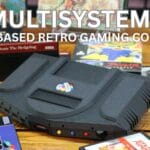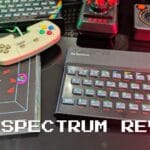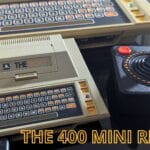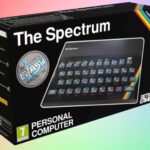Table of Contents
We check out the DivMMC Future Sinclair ZX Spectrum Instant Tape Loader Interface from The Future Was 8bit. The DivMMC Future does away with slow and unreliable cassette tape loading and stores your tape image files on a SD Card which can be instantly loaded on your ZX Spectrum. It is a jumperless board which means you do not have to mess around with jumpers or dipswitches in order for it to work on your model of Spectrum, or to update the firmware.
DivMMC Future Review Video
You can find out more about the DivMMC Future on the homepage at https://www.thefuturewas8bit.com/
DivMMC Future Review
The DivMMC Future allows you to load cassette tape software without the need for either a cassette tape or a tape deck. Cassette tapes can be unreliable now and you also have to wait bleedin ages for them to load. The DivMMC Future lets you load the image files of cassette tapes with the added bonus of near instant loading.
The Div series of interfaces have been around for some time. Here is my old DivMMC from some years ago, which is itself a derivative of a DivIDE, an ever older model.
And now more recently we have the DivMMC Future which is based on the DivMMC flash cartridge. The first thing you will notice is that it comes enclosed in a plastic injection moulded case. It is available in Classic Black, +2 Grey and Future White colours. It keeps the board protected from accidental touches, and the Sinclair rainbow stripe on the side helps keep it looking like an authentic peripheral for the Spectrum.
On the front of the case are two buttons. The first is an illuminated NMI button which shows the status of the DivMMC and can be pressed to access the menu. The button below that will reset the ZX Spectrum.
On the top of the interface you can find a full size SD Card slot which accepts FAT 16 and 32 formats. I am not sure what size card it will accept up to, but you shouldn’t really need more than a 8 or 16GB card.
To the right is the Kempston joystick port which is a godsend as it lets you use a much wider variety of joysticks such as Commodore ones. Previously you may have had to use another interface to add support for this, and it makes for a bulky and unstable connection when used with say the older DivMMC interface plugged in.
Lets just call it the DivMMC Future, the Future from now on. One big addition to the Future is that it is a jumperless board. This means that to use the Future on different model Spectrums as well as updating the firmware, you do not have to mess around with jumpers or dip switches.
Trust me, it was a pain in the arse trying to remember which settings you needed when using different models and updating the firmware. With the Future, it is simply plug and play and for updating the firmware essentially just copy over some files, then run a Tape file, it’s a piece of cake!
As a note, the Future can only run the ESXDOS firmware and is not compatible with other Div series firmwares such as FATware. The ESXDOS firmware is pretty decent and up to date, but it only displays 8.3 character filenames, even if your filenames are longer.
That is all there really is to it. So let’s get it plugged in and powered up.
Once booted up you are presented with your familiar Spectrum screen. In this case I am using my Spectrum +3 for easy video capture. On the +3 it will bypass the usual boot menu and go straight into 48K mode, but the full 128K of memory is accessible.
Pressing the NMI button will go straight to the file browser of your SD card. Pressing the H keyboard key will bring up the Help screen which gives an overview of what you can do. Returning to the file browser, you use the arrow Up and Down keyboard keys to navigate the files and folders, and Enter to select.
The Future supports a number of file formats; .tap, .z80, .scr, .sna, .trd, .basic. I mainly use .TAP and .Z80 formats as these are most common. I recommend putting each game inside its own folder, as when making Snapshots, they make a generic filename and can get mixed up with others. Keeping games in folders means they are easier to manage in the long run.
So you simply navigate to a supported file format and press the enter key and the program is instantly loaded. No more waiting 20 minutes for the tape to read and load the program!
Snapshots brings emulator style save/load state functions to the original hardware which is great.
At any time you can press the NMI button to return back to the file browser. From here you can use the Snapshot function which allows you to save the current memory contents to a file on the SD Card, and then resume it at a later date exactly where you left off.
Simply press the S keyboard key to save the file, it will name it SNAP0000.sna and future snapshots will increment this number. You can resume back to the running software by pressing the Space Bar, reset or turn off the Spectrum for example.
When you want to resume where you made the Snapshot, simply navigate back to the file, highlight it and you can press the V keyboard button to preview the Snapshot screen which is a very handy feature. Or press the Enter key to load the Snapshot into memory and resume exactly where you left off.
If you have used any emulators then you will know how useful Snapshots or Save States are, so this is a great feature.
Cassette tape multiloading is supported but you may find the occasional game not working. However this does seem to be more of a Spectrum +3 issue. For example on R-Type, the multi load works perfectly, and again with the bonus of being near instant. On a couple of other games I could not get it working as it required pressing Play on the tape deck.
That is pretty much the general overview of the DivMMC Future which will be enough for most users. There are more advanced uses including basic commands where you can interact with the Future.
- .ls – show directory listing
- .cd dirname – change directory into ‘dirname’
- .mkdir dirname – create a new directory called ‘dirname’
There are plenty of commands you can use and can find them on the ESXDos homepage.
The DivMMC Future is a great bit of kit if you have any model of Spectrum. With the jumperless board and integrated Kempston joystick interface, all enclosed in an authentic looking case, it is a must for any Speccy owner.
If you do have a Spectrum +3 then an alternative could be a Gotek drive emulator to load disk images. But you do lose features such as Snapshots which are quite useful. I have Goteks on most of my other disk based computers and never really desired it for the Spectrum as the tape images load near instantly. You should be able to use both a Future and Gotek together if you want to though.
You can find out more information on the DivMMC Future here.




